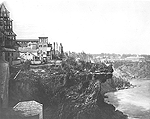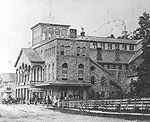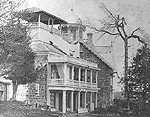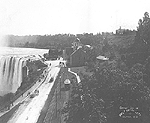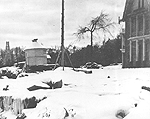The Table Rock area known as "the Front" in the 1870's courtesy of the Niagara Falls (Ontario) Public Library
The Front In 1827, Thomas Barnett built the first building along the Canadian bank of the Niagara Gorge near the Table Rock. This building was located approximately 300 feet south of the Table Rock. Here, Barnett established the Table Rock Museum. Barnett built a stairway to the base of the gorge and the foot of the Horseshoe Falls. This was in direct competition with Isaiah Starkey who also operated a similar staircase. Barnett offered tourists a tour "Behind the Sheet" which included a walking tour to the base of the Horseshoe Falls and along a short ledge behind the falling water. During the early 1840's, Thomas Barnett built his second museum at the base of Murray Hill Ravine (presently Murray Hill). Barnett then built a zoological museum in an old distillery located on the north side of Murray Hill ravine opposite his museum. This museum contained 5,000 specimens. In 1844, Saul Davis of Buffalo, New York built the Prospect House (hotel) south of Barnett's new museum. Other businesses soon were built in the area of the Table Rock. In 1852, William Hamilton Merritt, president of the St. Catharines, Thorold & Niagara Falls Toll Road Company sought permission to build a toll road from Ferry Road (currently Clifton Hill) to the Table Rock. Unfortunately for Merritt, a road had already been partially established along the nine acre chain reserve by the Suspension Bridge Company. This road was named Front Street. The portion of Front Street from Murray Hill ravine to the Table Rock became known as "the Front". In 1853, Saul Davis relinquished ownership of the Prospect House to his cousin, Colonel Isaacs. Davis then built a hotel immediately south of Barnett's Table Rock Museum. Davis named his hotel, the Table Rock House. Competition between Barnett, Davis and other businessmen was furious and erupted in many arguments. The Front became a tourist trap of seedy curiosity shops, souvenirs, hotels and museums. Many undesirable persons such as thieves, scam artists and prostitutes. Saul Davis' Table Rock House became known as the "Den of the Forty Thieves", a reputation which may not have been too far off the mark.
Barnett's Museum in the
1890's courtesy of the Niagara Falls (Ontario) Public Library
In 1859, Thomas Barnett erected a new building to house his museum at the foot of Murray Hill ravine. Under the terms of a joint lease agreement, Barnett had the right of passage along the base of the gorge up to and Behind the Sheet" at the base of the Horseshoe Falls. In 1860, Saul Davis had been granted a lease from the Crown to build a staircase and to allow tourists to tour "Behind the Sheet" which included a walking tour to the base of the Horseshoe Falls which had been previously established by Thomas Barnett. This lease was conditional providing that Saul Davis allow free access to the Falls by a pathway at the foot of the Table Rock and further to charge persons using his new staircase no more than 25¢. Davis ignored the terms of this lease by making free passage to the Falls nearly impossible. In 1861, Davis built a stone wall with a gate at the north end of his property. Davis closed and locked this gate which resulted in Barnett's customers from being allowed access to the Behind the Sheet as agreed to in the joint lease. In 1862, the joint lease was cancelled. The relationship between Thomas Barnett and Saul Davis had deteriorated to open hostility. On April 23rd 1865, Davis' staircase to the base of the gorge was burned to the ground. The cause of the fire was established as a case of arson. With the destruction of his staircase, Davis was forced to ask Thomas Barnett to use his staircase for free. Barnett refused. Supporters of Saul Davis began throwing objects and stones over the edge of the gorge in order to prevent Barnett's customers safe access along the base of the gorge. On December 19th 1865, a restraining order was issued against Saul Davis preventing he or any of his supporters from hindering and interfering with Barnett and access into the gorge for his customers. In 1866, Saul Davis obtained another lease to build and operate a new staircase. Davis sold his lease to Rolland MacDonald. In 1867, Canada became a nation. The Chain Reserve came under the jurisdiction of the Province of Ontario. In 1869, Thomas Barnett obtained a Crown lease which gave him full access of the talus slope from his museum to the base of the Horseshoe Falls. Saul Davis erected a new stairway and began taking tourists "Behind the Sheet". On the evening of June 25th 1870, Edward Davis (son of Saul Davis) was walking past Barnett's Museum at the base of Murray Hill ravine when he was attacked by a group of Barnett supporters throwing stones and sticks. Fearing for his life, Edward Davis drew a gun and shot one of his attackers; killing him. Edward Davis was charged with murder but was acquitted at trail.
The Barnett's Table
Rock House in the 1860's courtesy of the Niagara Falls (Ontario) Public Library
During the Barnett - Davis feud, three staircases into the gorge had been destroyed. Thomas Barnett suffered severe financial hardship as a result of this 33 year dispute. In 1877, Thomas Barnett went bankrupt. His museums and other buildings were sold for debt relief. All of Barnett's assets were ironically purchased by his nemesis, Saul Davis. Davis now had sole control over the Front and continued to operate for another ten years before the establishment of the Niagara Falls - Queen Victoria Park.
Behind the Sheet
The Table Rock and Queen Victoria Park in 1899 courtesy of the Niagara Falls (Ontario) Public Library
In 1827, Thomas Barnett began offering tourists a tour "Behind the Sheet" which included a walking tour to the base of the Horseshoe Falls and along a short ledge behind the falling water. In 1887, the Niagara Falls - Queen Victoria Park Commission decided that the circular staircase leading to the "Behind the Sheet" tour at the base of the Horseshoe Falls should be replaced with a hydraulic lift. The Fensom Elevator Works Company of Toronto was selected to install this lift for $7,300.00. The hydraulic lift could carry up to 10 people at a time on a 45 second journey to the base of the gorge. The lift car rose in a wrought iron open caged tower. Water required for use of this hydraulic lift was piped in from the upper Niagara River approximately six hundred (600) feet away. In the winter, the iron tower was enclosed in wooden shutters to prevent damaging ice accumulation. At the base of the elevator, a wide observation platform was erected with a wooden boardwalk leading from it to the river below. During the Spring of 1889, a major rock fall at the center of the Horseshoe Falls, diminished the flow of water over the Falls along the Canadian shore. With little water, the "Behind the Sheet" attraction as it was known was closed after being a major attraction for 62 years.
On June 6th 1893, the company of Zybach and Brundage were granted an exclusive ten year lease to operate the hydraulic lift, the Under the Falls attraction and photography business at the Table Rock. In 1902, as part of the pipeline & powerhouse agreement, the Ontario Power Company agreed to build a tunnel eight hundred (800) feet (244 m) behind the Horseshoe Falls and construct an elevator connecting this tunnel and provide free power for the elevator operation for a ten year period. In exchange the Ontario Power Company would take over the existing hydraulic lift to take it's employees to and from their new power generating station at the base of the Falls. In addition, the existing Dufferin Cafe building would be torn down to allow the underground pipeline and hydro line distribution. The Ontario Power Company provided the Parks Commission with monetary compensation for the rebuilding of a new Refectory. The initial tunnel was built by the Ontario Power Company. Workers bored through layers of differing rock and clays. It was 800 feet (244m) long, 7 feet (2m) high and 4½ feet (1.4m) wide. By 1903, the new elevator and tunnel had been completed and ready for the tourist season. For the most part of 1916 - 1917 during WW1 , the tunnels were closed when the Canadian Army occupied Queen Victoria Park. By 1924, the Horseshoe Falls had receded to the point that the portals build in 1903 were now exposed. As a result, a 180 foot (55m) long extension was made to the tunnel extending under the Horseshoe Falls. In June of 1940, Queen Victoria Park from the Refectory to Dufferin Islands was closed. Table Rock and the scenic tunnels were closed to the public. On September 29th 1944, the military barricades were removed and Queen Victoria Park re-opened to the public. An inspection of the scenic tunnels revealed that gorge erosion had rendered the tunnels unsafe. The tunnel wall thickness had diminished to only 5½ feet between the tunnel and the gorge wall. A new tunnel was bored sixty (60) feet back from the former tunnel. The new tunnel was lined with concrete and electrically lighted. In 1951, an outdoor observation platform was built at the end of a branch of the old tunnel. In 1932, a commemorative plaque was erected to mark the site of the original Table Rock House which stood since being erected by Saul Davis in 1853.
The Table Rock
Samuel Barnett's Camera
Obscura and House at the Table Rock courtesy of the Niagara Falls (Ontario) Public Library
The Table Rock House and the starting point for this tunnel trip was the oldest building in the park and was considered unsightly. The Parks Commissioners decided to build a modern Table Rock House a short distance south of the old Table Rock structure. The new building would allow a full view of the Horseshoe Falls. By 1902, the Parks Commissioners wanted to replace the existing Table Rock House but had to delay this proposal until the expiry of the Zybach & Brundage lease on June 1st 1913. The Zybach & Brundage lease was not renewed. Instead the Parks Commissioners awarded a two year lease to R.P. Slater for 1915 - 1916. During 1916 as a result of WW1 , the Table Rock House was closed and the military barricaded Queen Victoria Park from the Refectory to Dufferin Islands in order to protect the power generating stations. Slater's lease to operate the Table Rock House was revoked. During the winter of 1916 - 1917, Table Rock House was used as headquarters for the Canadian Army. During this period, the Parks Commission was responsible to provide suitable accommodations for the troops. Bunk houses were built as were guard houses at the entrances to Queen Victoria Park. The military guard remained until the Spring of 1917. At this time the existing buildings were occupied by the Ontario Power Company and their employees. By 1924, the existing Table Rock House (which was built by Saul Davis in 1853) had become unsightly and occupied space at the narrowest point of the park between the river and the moraine. Construction of the new table Rock building began in September of 1925. The architectural firm Findlay & Foulis of Sault Ste. Marie designed the new Table Rock House. Demolition of the old building was completed in May of 1926. Because of the location of the new building, a branch tunnel needed to be built to connect to the main tunnel leading to the Horseshoe Falls. In 1925, It was built south of the old building and closer to the Horseshoe Falls. The new building also served as a station for the electric railway. In 1939, with the beginning of WW2, the Canadian Army set up barbed-wire barricades around the power stations in Queen Victoria Park. In June of 1940, the Canadian Army closed Queen Victoria Park from the Refectory to Dufferin Islands. The Table Rock and the Scenic Tunnels were closed to the public. Queen Victoria Park remained closed for nearly four years. On September 29th 1944, the military barricades were removed and Queen Victoria Park re-opened to the public. In 1963, extensive alterations were made to the Table Rock House.
Date last updated:
February 20, 2012
THANK YOU FOR VISITING
|
||||||||||
